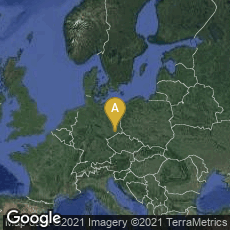

A: Plauen, Dresden, Sachsen, Germany
On December 29, 1931 Emanuel Goldberg of Zeiss Ikon in Dresden received U.S. Patent No. 1,838,389 for a photoelectric microfilm selector which he called "Statistical Machine." Goldberg designed the machine by May 1927. The patent, applied for in 1928, and similar patents Goldberg obtained in other countries, described an electromechanical machine for searching through data encoded on reels of film using on which information was stored, "radiating energy to actuate a recorder when the explored indications upon the search plate and record element are identical, the indications on one of said elements being penetrable by the rays and the indication on the other element being impenetrable by the rays."
"Two prototypes were built at Zeiss Ikon by 1931 and, perhaps, constitute the first successful electronic document retrieval. Microfilm selector technology was known in at least two leading research centers in the U.S.A. (Eastman Kodak and IBM) by 1931 or shortly thereafter and in both cases a direct connection to Goldberg can be shown. This technology was reported at international congresses in 1931 and 1935 and a number of U.S. inventors were working on it by 1938 (e.g. Bryce, H. Davis, Gould, and Morse)" (http://people.ischool.berkeley.edu/~buckland/goldbush.html, accessed 02-20-2012).
Vannevar Bush incorporated technology similar to this in the Rapid Selector machine on which he began development in 1938. The existence of Goldberg's patent prevented Bush from patenting his Rapid Selector, that came to be known as the Memex. Bush's Memex became famous conceptually after publication in 1945 of his article, "As We May Think."